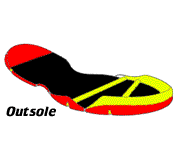Outsole : How are the outsoles patterns on shoes used in the same or different sports?
 The main function of the outsole is to provide traction as well as to reduce wear on the midsole thereby increasing the overall durability of the shoe.
The main function of the outsole is to provide traction as well as to reduce wear on the midsole thereby increasing the overall durability of the shoe.Flexibility - In some types of shoes, like bicycle road racing shoes, flexibility is not required, in fact, it is a liability. The cyclist needs to transfer all of the muscular energy produced by pedaling straight into the movement of her bike. Any wasted movement, like side to side movement or flexion of the foot, other than at the ankle, is wasted energy. Therefore a cyclist's shoe has a very stiff, relatively inflexible outsole. A basketball player on the other hand, like a runner, needs to have the shoe flex where the foot naturally flexes. Designers and sport researchers, similar to the design considerations for cushioning, must keep in mind the natural flex lines of the foot relative the specific need of the sport.
 Traction - As mentioned earlier how well a shoe needs to grip depends on the sporting event. A cross country runner might need a different shoe on a rainy day than they would need on a hard compacted surface. A basketball player needs an outsole that will grip well when running, but not when they are pivoting. A basketball player also needs a shoe that will not stop them so suddenly, or grab, when the are trying to stop as this can cause them to turn there ankle and injure themselves. The traction properties of a shoe, really a measure of the friction between the outsole and the playing surface, are directly related to the materials used in the outsoles construction as well as the pattern on the outsole.
Traction - As mentioned earlier how well a shoe needs to grip depends on the sporting event. A cross country runner might need a different shoe on a rainy day than they would need on a hard compacted surface. A basketball player needs an outsole that will grip well when running, but not when they are pivoting. A basketball player also needs a shoe that will not stop them so suddenly, or grab, when the are trying to stop as this can cause them to turn there ankle and injure themselves. The traction properties of a shoe, really a measure of the friction between the outsole and the playing surface, are directly related to the materials used in the outsoles construction as well as the pattern on the outsole.Durability - As an athlete runs in a shoe, the outsole wears away, due to friction. In particular the parts of the shoe that come into contact with the ground the most, wear away the fastest. Researchers and designers must take into account the points of contact specific to a sport in order to design outsoles that do not wear out to quickly. One would think that scientists could come up with outsoles that would never wear out. "Eternal life" outsoles might be possible, but could lend a false sense of security to the wearer. If a runner, for example, only paid attention to outsole wear as an indicator as to when new shoes should be purchased, they might continue to wear shoes that have lost their cushioning or overall motion control due to the midsole breaking down. From Slam Dunk Science


0 Comments:
Post a Comment
<< Home